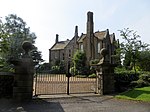Club Row, Longridge
1793 establishments in EnglandBuildings and structures in Ribble ValleyGrade II listed buildings in LancashireHouses completed in 1793Houses in Lancashire ... and 2 more
LongridgeUse British English from September 2021

Club Row is a row of sandstone terraced houses on Higher Road in the English market town of Longridge, Lancashire, built between 1793 and 1804. Grade II listed, and numbered 6 to 44, they each have slate roofs and were built by the Longridge Building Club, one of the earliest terminating building societies in England. They have two storeys and cellars entered at the rear, and each house has one bay. The windows and doorways have plain surrounds. The doorways are grouped in threes, the centre door leading to the rear yard. The cellars were used for handloom weaving.
Excerpt from the Wikipedia article Club Row, Longridge (License: CC BY-SA 3.0, Authors, Images).Club Row, Longridge
Higher Road, Ribble Valley Longridge
Geographical coordinates (GPS) Address Nearby Places Show on map
Geographical coordinates (GPS)
| Latitude | Longitude |
|---|---|
| N 53.83114 ° | E -2.59676 ° |
Address
Higher Road
Higher Road
PR3 3SX Ribble Valley, Longridge
England, United Kingdom
Open on Google Maps







